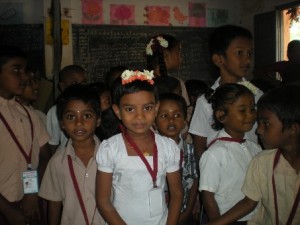I admit it – I am a lifelong learner. A fanatic about it. I loved school and love teaching at the university level. Amazon loves me even more – a steady stream of new books arrives weekly.
So I am alarmed when I see the state of our educational system. I am disheartened when my students tell me, en mass, that they never read. I am discouraged when I see parents bash teachers, teachers bash the administration, and the administration wondering who to blame. I cringe when I see the extent that we are teaching to a test – with right and wrong, black and white answers to questions which might not even matter. All this when in today’s world we desperately need critical thinking, strong analytical skills, creativity, and working with both the blessing and curse of having more information at our fingertips than we could ever absorb in 20 lifetimes, thanks to Google.
Our educational system stands in stark contrast to what I experienced in India. That experience started when, in preparation, those we were going to visit were asked to provide a list of things we might bring them. Number one on the list: a pencil sharpener – a real one – one that you hang on the wall. And of course, pencils would be nice.
Then, while in India, I had the chance to spend two hours at the “tuition center” – run for the school-aged children of Blue Mango employees – and then to visit a village elementary school and preschool. Let me begin by describing my experience at the tuition center.
The tuition center is what we would call an after-school or homework center. Six days a week (and sometimes on Sunday) the school-aged children of women who work at Blue Mango gather from 5 to 7 pm. They are guided by three of the Blue Mango staffers, and engage in learning activities. The room is sparse – one small table, a chalk board, and two well-past-their-prime laptops with a typing program loaded on them.
As the children arrive, they are divided into 3 age groups, and each is assigned an activity and a staff member to work with. The children bring a backpack – with a mat, a slate and a few pieces of chalk. The energy is high, and remains so for the entire two hours. The focus in intense – I worked with the younger children on a 500 piece puzzle (a new treasure brought from America – but terribly puzzling to those who had never encountered a puzzle). Yet not one child, even the youngest, gave up. And finally, after an excruciatingly long time and great effort, the border of the puzzle emerged – much to my relief. Older children are learning English – with a carefully planned game – and making visible progress in the midst of the laughter.
During our two hours there, I noticed a great number of knocks on the door and a continual commotion outside. Later I found out the source – other village children whose mothers did NOT work at Blue Mango and who were crying at the door asking to be allowed to come in.
A day later, as the Blue Mango women were asked what they valued the most about working at Blue Mango (from a list of 18 possibilities), the tuition center came up time and time again. When asked what else they would like to see, tuition centers for other surrounding villages was identified. Enhancing the education of their children trumped higher wages and better benefits – in spite of the fact that most had very little and every Rupee counted.
 Two days later we had a chance to visit an elementary school and preschool in a local village. There was one large room that housed students from ages 6 to 12. Approximately 50 students were under the tutelage of 2 teachers, one with the younger students, one with the older. Supplies were more plentiful than the tuition center – but not by much. Chalk boards and chalk were predominant, and printed materials were in short supply. The children were bright-eyed and eager to show us what they were learning. They pushed and squirmed their way to get our attention – and showed us proudly their writing, their math work, their science projects, and their art work. They practiced their English with us – with great glee combined with a serious desire to make it better. Again, the energy and strong desire to learn was clear in every student and in every action.
Two days later we had a chance to visit an elementary school and preschool in a local village. There was one large room that housed students from ages 6 to 12. Approximately 50 students were under the tutelage of 2 teachers, one with the younger students, one with the older. Supplies were more plentiful than the tuition center – but not by much. Chalk boards and chalk were predominant, and printed materials were in short supply. The children were bright-eyed and eager to show us what they were learning. They pushed and squirmed their way to get our attention – and showed us proudly their writing, their math work, their science projects, and their art work. They practiced their English with us – with great glee combined with a serious desire to make it better. Again, the energy and strong desire to learn was clear in every student and in every action.
 The preschool had a handful of children, starting with toddlers. They were lovingly cared for by several women, and were quite startled by the appearance of 6 white women in their space (and we were quite a sight!) I, too, was startled – while clearly nicely cared for, the room was as sparse as a jail cell, with only a few badly tattered remnants of toys. I recognized 1/4 of one part of a Fisher Price toddler toy as one small tike handed it to me. I immediately contrasted it to the amazing treasure trove my granddaughter had – her stack of board books, her blocks and dolls and cars and wheel toys. The discrepancy still haunts me.
The preschool had a handful of children, starting with toddlers. They were lovingly cared for by several women, and were quite startled by the appearance of 6 white women in their space (and we were quite a sight!) I, too, was startled – while clearly nicely cared for, the room was as sparse as a jail cell, with only a few badly tattered remnants of toys. I recognized 1/4 of one part of a Fisher Price toddler toy as one small tike handed it to me. I immediately contrasted it to the amazing treasure trove my granddaughter had – her stack of board books, her blocks and dolls and cars and wheel toys. The discrepancy still haunts me.
I compare this to all that we have in the U.S.. Educated teachers, buildings with furniture and supplies, support staff, auxiliary programming, the internet and computers. Yet the image that comes to my mind is that so many of our children are crying to get out of school rather than crying to get in. That our parents have abdicated caring about education to the system – and then are quick to blame, and reticent to step in and motivate and encourage. That our professionals continue to ask for more and more, rather than asking what they can do with what they have.
The end result of both systems is failure. The motivation to learn is high in India but the infrastructure is weak. In the U.S., there is a robust infrastructure but motivation is low. My expertise in helping people and organizations change tells me that in order to effect change, there must be both motivation and skill. Just wanting is not enough – there must be a system, a process, or a person, that imparts the skill to do the new thing one desires.
I wonder what might happen in the U.S. if we changed the dialogue. What if:
- We asked what we might do with the ample resources we have instead of asking for more?
- We acknowledged and appreciated deeply that teaching, parenting, and administrating schools is a tough job – and we asked how we might support each other rather than point fingers and lay blame?
- Curiosity, self-activated learning, critical thinking and solid analytical skills were seen as the goal, rather than an arbitrary test score on a predetermined date from a standardized test?
- We deeply valued education and our education system, instead of seeing it as an entitlement?
- Each one of us encouraged the youth we touch; and model being excited about learning?
The topic is difficult and I’m not an expert. But I know if we combined our educational infrastructure, resources, and teaching talent with a population of children who were highly motivated to learn – amazing things would result.





One Response
Kris, your post is spot-on! As an organization whose mission is to improve the lives of children and youth, your questions posed at the end are ones everyone should give more thought and consideration. I especially appreciated your point about Americans viewing education as an entitlement, rather than the privilege it truly is! Our organization provides untold volunteer hours and nearly $300,000 every year in the form of scholarships, service projects and service leadership clubs we sponsor in schools, ranging from grad school through college…and we find that most of the kids who get involved with these mini-Kiwanis club clones are hungry to learn and appreciative of the chance to pay it forward and better their community.
Comments are closed.